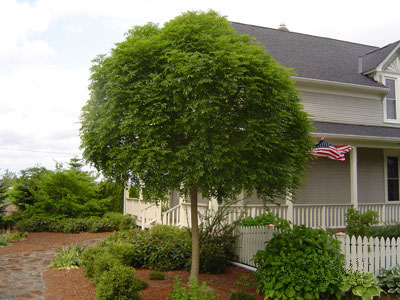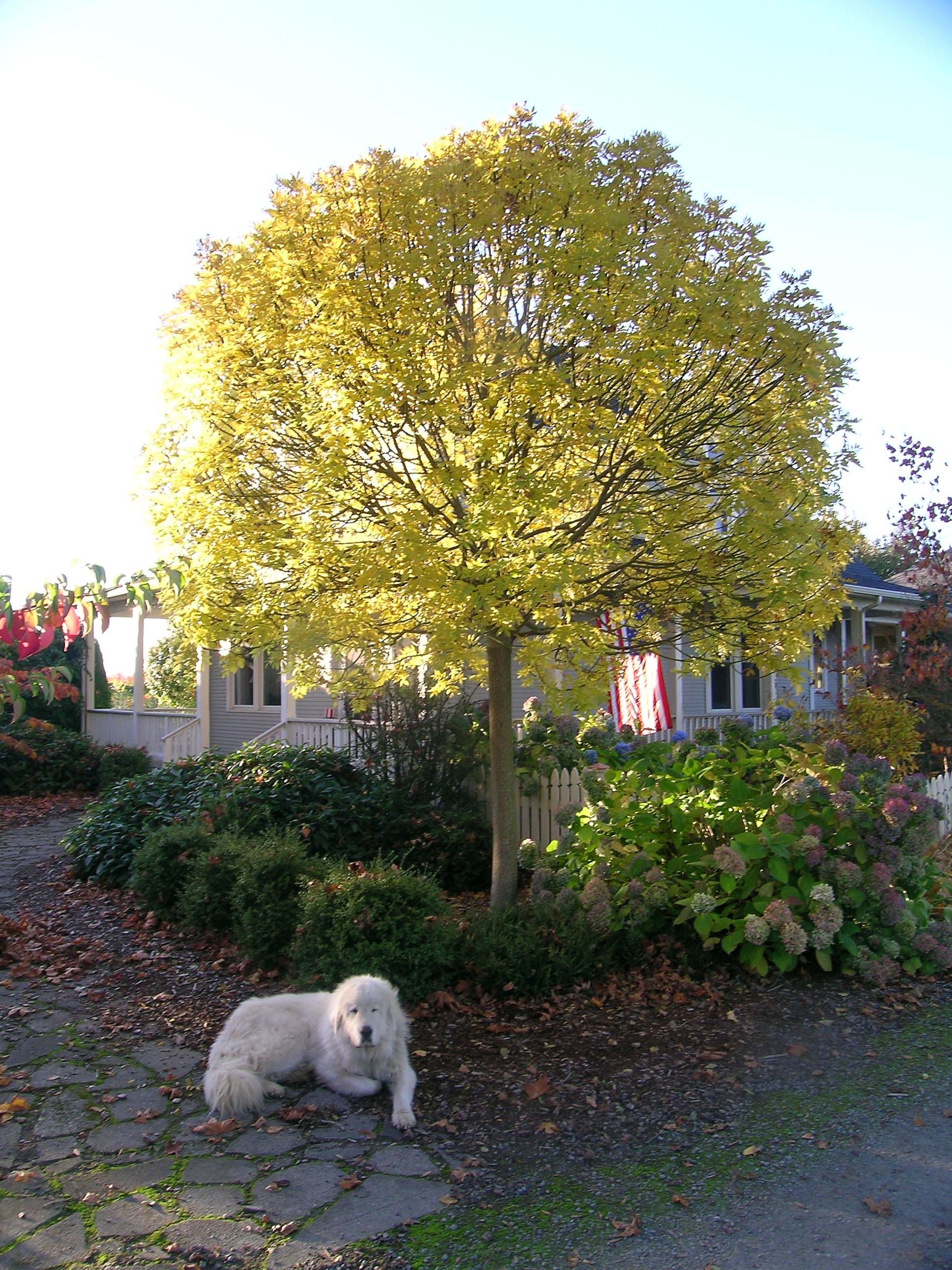Globehead European Ash
Fraxinus excelsior 'Globosa'
The Globehead European Ash is one tree I suspect few of you have seen unless you have visited our nursery in Mount Vernon, WA. First, a little history. We originally purchased this tree from Handy Nursery in Oregon many years ago, tried to get more, but found it was discontinued there. Apparently, small trees were not high-value then. We looked all over the country for liners, and finding none, decided to grow our own. With the help of Biringer Nursery (also in Mount Vernon), we took our cuttings and grafted them on top of Patmore Standards. The unions appear to be very good. Speaking recently with Dr. Ware at the Morton Arboretum, we determined there was an advantage to placing ‘excelsior’, which is not happy with wet soil conditions, onto a Patmore Standard (trunk) on top of a green or white ash root stock which tolerates moist soil conditions. So far, we are seeing excellent results.
Globe Ash has a slow-to-moderate growth rate, naturally forming a very round tight globe form, with no pruning needed. The twigs are fat and buds very large, typical of an excelsior. We have seen no seed. They have typical compound ash leaves of 9 to 11 sharply-toothed leaflets. Summer leaf color is a pleasant green turning yellow in fall. Leaves turn and drop very quickly and seem to decompose much faster than maple or oak. Although not a brittle tree, the limbs and twigs are stout enough even when young that they do not bend much when stressed. For this reason, we are graphing them at 7 feet on the trunk to start them high enough out of pedestrian traffic. I would not place them close to a drive lane however, because of the importance of maintaining the globe form and structure. The tree also appears to prefer full sun, becoming less dense with any shade.
compound ash leaves of 9 to 11 sharply-toothed leaflets. Summer leaf color is a pleasant green turning yellow in fall. Leaves turn and drop very quickly and seem to decompose much faster than maple or oak. Although not a brittle tree, the limbs and twigs are stout enough even when young that they do not bend much when stressed. For this reason, we are graphing them at 7 feet on the trunk to start them high enough out of pedestrian traffic. I would not place them close to a drive lane however, because of the importance of maintaining the globe form and structure. The tree also appears to prefer full sun, becoming less dense with any shade.
In this age of smaller spaces, the Globehead European Ash is ideal. It has a formal look if needed and is well behaved, needing little, if any, pruning after installation. Leaf growth is primarily on the outer edge of the crown forming almost a “globe” of leaves to form the crown. Interior twigs without sunlight decline, dieback, and literally fall off the tree. I see this tree as especially suitable for downtown street trees, patios, and formal gardens. I would really like to know if anyone has seen larger specimens in their area and what their history has been. Please contact us if you know of any.
Fraxinus excelsior 'Globosa'

The Globehead European Ash is one tree I suspect few of you have seen unless you have visited our nursery in Mount Vernon, WA. First, a little history. We originally purchased this tree from Handy Nursery in Oregon many years ago, tried to get more, but found it was discontinued there. Apparently, small trees were not high-value then. We looked all over the country for liners, and finding none, decided to grow our own. With the help of Biringer Nursery (also in Mount Vernon), we took our cuttings and grafted them on top of Patmore Standards. The unions appear to be very good. Speaking recently with Dr. Ware at the Morton Arboretum, we determined there was an advantage to placing ‘excelsior’, which is not happy with wet soil conditions, onto a Patmore Standard (trunk) on top of a green or white ash root stock which tolerates moist soil conditions. So far, we are seeing excellent results.
Globe Ash has a slow-to-moderate growth rate, naturally forming a very round tight globe form, with no pruning needed. The twigs are fat and buds very large, typical of an excelsior. We have seen no seed. They have typical
 compound ash leaves of 9 to 11 sharply-toothed leaflets. Summer leaf color is a pleasant green turning yellow in fall. Leaves turn and drop very quickly and seem to decompose much faster than maple or oak. Although not a brittle tree, the limbs and twigs are stout enough even when young that they do not bend much when stressed. For this reason, we are graphing them at 7 feet on the trunk to start them high enough out of pedestrian traffic. I would not place them close to a drive lane however, because of the importance of maintaining the globe form and structure. The tree also appears to prefer full sun, becoming less dense with any shade.
compound ash leaves of 9 to 11 sharply-toothed leaflets. Summer leaf color is a pleasant green turning yellow in fall. Leaves turn and drop very quickly and seem to decompose much faster than maple or oak. Although not a brittle tree, the limbs and twigs are stout enough even when young that they do not bend much when stressed. For this reason, we are graphing them at 7 feet on the trunk to start them high enough out of pedestrian traffic. I would not place them close to a drive lane however, because of the importance of maintaining the globe form and structure. The tree also appears to prefer full sun, becoming less dense with any shade.In this age of smaller spaces, the Globehead European Ash is ideal. It has a formal look if needed and is well behaved, needing little, if any, pruning after installation. Leaf growth is primarily on the outer edge of the crown forming almost a “globe” of leaves to form the crown. Interior twigs without sunlight decline, dieback, and literally fall off the tree. I see this tree as especially suitable for downtown street trees, patios, and formal gardens. I would really like to know if anyone has seen larger specimens in their area and what their history has been. Please contact us if you know of any.
Jim Barborinas
ISA Certified Arborist #0135
ASCA Registered Consulting Arborist #356 CLICK HERE FOR MORE TREE PROFILES
Certified Tree Risk Assessor #PNW-0327
ISA Certified Arborist #0135
ASCA Registered Consulting Arborist #356 CLICK HERE FOR MORE TREE PROFILES
Certified Tree Risk Assessor #PNW-0327
15119 McLean Road
Mount Vernon, WA 98273
(O) 360-428-5810
(M) 360-770-9921
(F) 360-428-1822
sales@urbanforestnursery.com
Mount Vernon, WA 98273
(O) 360-428-5810
(M) 360-770-9921
(F) 360-428-1822
sales@urbanforestnursery.com


